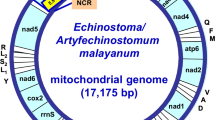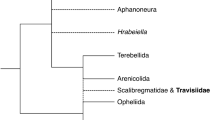Abstract
Echinostomes are a diverse group of digenetic trematodes that are difficult to classify by predominantly traditional techniques and contain many cryptic species. Application of contemporary genetic/molecular markers can provide an alternative choice for comprehensive classification or systematic analysis. In this study, we successfully characterized the intron 5 of domain 1 of the taurocyamine kinase gene (TkD1Int5) of Artyfechinostomum malayanum and the other two species of the 37 collar-spined group, Echinostoma revolutum and Echinostoma miyagawai, whereas TkD1Int5 of Hypoderaeum conoideum cannot be amplified. High levels of nucleotide polymorphism were detected in TkD1Int5 within E. revolutum and E. miyagawai, but not in A. malayanum. Thus, TkD1Int5 can be potentially used as genetic marker for genetic investigation of E. miyagawai and E. revolutum. We therefore used TkD1Int5 to explore genetic variation within and genetic differentiation between 58 samples of E. miyagawai and five samples of E. revolutum. Heterozygosity was observed in 17 and two samples with 16 and three insertion/deletion (indel) patterns in E. miyagawai and E. revolutum, respectively. Heterozygous samples were then cloned and nucleotide sequence was performed revealing the combined haplotypes in a particular sample. Based on nucleotide variable sites (excluding indels), the 72 E. miyagawai and seven E. revolutum haplotypes were subsequently classified. The haplotype network revealed clear genetic differentiation between E. miyagawai and E. revolutum haplogroups, but no genetic structure correlated with geographical localities was detected. High polymorphism and heterogeneity of the TkD1Int5 sequence found in our study suggest that it can be used in subsequent studies as an alternate independent potential genetic marker to investigate the population genetics, genetic structure, and possible hybridization of the other echinostomes, especially the 37 collar-spined group distributed worldwide.


Similar content being viewed by others
References
Anucherngchai S, Chontananarth T, Tejangkura T, Chai JY (2019) The study of cytochrome B (CYTB): species-specific detection and phylogenetic relationship of Echinostoma revolutum, (Froelich, 1802). J Parasit Dis 43:66–74
Bandelt HJ, Forster P, Rohl A (1999) Median-joining networks for inferring intraspecific phylogenies. Mol Biol Evol 16:37–48
Bhaibulaya M, Harinasuta C, Trirachantra S (1966) The finding of Echinostoma revolutum infection in man in Thailand. J Med Assoc Thail 49:83–92
Chai JY (2019) Echinostomes. In: Chai JY (ed) Human intestinal flukes from discovery to treatment and control. Springer Nature BV, Netherland, pp 169–344
Chai JY, Sohn WM, Yong TS, Eom KS, Min DY, Hoang EH, Phammasack B, Insisiengmay B, Rim HJ (2012) Echinostome flukes receovered from humans in Khammouane Province, Lao PDR. Korean J Parasitol 50:269–272
Detwiler JT, Bos DH, Minchella DJ (2010) Revealing the secret lives of cryptic species: examining the phylogenetic relationships of echinostome parasites in North America. Mol Phylogenet Evol 55:611–620
Eom KS, Rim HJ, Jang DH (1984) A study on the parasitic helminths of domestic duck (Anas platyrhynchos var. domestica Linnaeus) in Korea. Kisaengchunghak Chapchi 22:215–221
Excoffier L, Lischer HE (2010) Arlequin suite ver 3.5: a new series of programs to perform population genetics analyses under Linux and Windows. Mol Ecol Resour 10:564–567
Fried B, Graczyk TK (2004) Recent advances in the biology of Echinostoma species in the "revolutum" group. Adv Parasitol 58:139–195
Fu YT, Jin YC, Li F, Liu GH (2019) Characterization of the complete mitochondrial genome of the echinostome Echinostoma miyagawai and phylogenetic implications. Parasitol Res 118:3091–3097
Georgieva S, Selbach C, Faltynkova A, Soldanova M, Sures B, Skirnisson K, Kostadinova A (2013) New cryptic species of the ‘revolutum’ group of Echinostoma (Digenea: Echinostomatidae) revealed by molecular and morphological data. Parasit Vectors 6:64
Hall TA (1999) BioEdit: a user-friendly biological sequence alignment editor and analysis program for Windows 95/98/NT. Nucleic Acids Symp Ser 41:95–98
Heneberg P (2020) Taxonomic comments on the validity of Echinostoma miyagawai Ischii, 1932 (Trematoda: Echinostomatidae). Parasitol Int 74:101931
Huffman JE, Fried B (1990) Echinostoma and echinostomiasis. Adv Parasitol 29:215–269
Jarilla BR, Tokuhiro S, Nagataki M, Uda K, Suzuki T, Acosta LP, Agatsuma T (2013) Gene structure of the two-domain taurocyamine kinase from Paragonimus westermani: evidence for a distinct lineage of trematode phosphagen kinases. FEBS Lett 587:2278–2283
Kostadinova A, Gibson DI (2000) The systematics of the echinostomes. In: Fried B, Graczyk TK (eds) Echinosotomes as experimental models for biological research. Kluwer Academic Publishers, Dordrecht, pp 31–57
Kostadinova A, Herniou EA, Barrett J, Littlewood DT (2003) Phylogenetic relationships of Echinostoma Rudolphi, 1809 (Digenea: Echinostomatidae) and related genera re-assessed via DNA and morphological analyses. Syst Parasitol 54:159–176
Larkin MA, Blackshields G, Brown NP, Chenna R, McGettigan PA, McWilliam H, Valentin F, Wallace IM, Wilm A, Lopez R, Thompson JD, Gibson TJ, Higgins DG (2007) Clustal W and Clustal X version 2.0. Bioinformatics 23:2947–2948
Li Y, Qiu YY, Zeng MH, Diao PW, Chang QC, Gao Y, Zhang Y, Wang CR (2019) The complete mitochondrial genome of Echinostoma miyagawai: comparisons with closely related species and phylogenetic implications. Infect Genet Evol 75:103961
Librado P, Rozas J (2009) DnaSP v5: a software for comprehensive analysis of DNA polymorphism data. Bioinformatics 25:1451–1452
Morgan JA, Blair D (1998) Mitochondrial ND1 gene sequences used to identify echinostome isolates from Australia and New Zealand. Int J Parasitol 28:493–502
Nagataki M, Tantrawatpan C, Agatsuma T, Sugiura T, Duenngai K, Sithithaworn P, Andrews RH, Petney TN, Saijuntha W (2015) Mitochondrial DNA sequences of 37 collar-spined echinostomes (Digenea: Echinostomatidae) in Thailand and Lao PDR reveals presence of two species: Echinostoma revolutum and E. miyagawai. Infect Genet Evol 35:56–62
Noikong W, Wongsawd C, Chai JY, Saenphet S, Trudgett A (2014) Molecular analysis of echinostome metacercariae from their second intermediate host found in a localised geographic region reveals genetic heterogeity and possible cryptic speciation. PLoS Negl Trop Dis 8:e2778
Pitaksakulrat O, Webster BL, Webster JP, Laha T, Saijuntha W, Lamberton P, Kiatsopit N, Andrews RH, Petney TN, Sithithaworn P (2018) Phylogenetic relationships within the Opisthorchis viverrini species complex with specific analysis of O. viverrini sensu lato from Sakon Nakhon, Thailand by mitochondrial and nuclear DNA sequencing. Infect Genet Evol 62:86–94
Saijuntha W, Sithithaworn P, Duenngai K, Kiatsopit N, Andrews RH, Petney TN (2011a) Genetic variation and relationships of four species of medically important echinostomes (Trematoda: Echinostomatidae) in South-East Asia. Infect Genet Evol 11:375–381
Saijuntha W, Tantrawatpan C, Sithithaworn P, Andrews RH, Petney TN (2011b) Spatial and temporal genetic variation of Echinostoma revolutum (Trematode: Echinostomatidae) from Thailand and Lao PDR. Acta Trop 118:105–109
Saijuntha W, Tantrawatpan C, Jarilla BR, Agatsuma T, Andrews RH, Petney TN (2016) Intron sequence of the taurocyamine kinase gene as a marker to investigate genetic variation of Paragonimus species in Japan and the origins of triploidy in P. westermani. Trans R Soc Trop Med Hyg 110:67–73
Saijuntha W, Tantrawatpan C, Wang C, Agatsuma T, Intapan PM, Maleewong W, Petney TN (2018) Revealing genetic hybridization and DNA recombination of Fasciola hepatica and Fasciola gigantica in nuclear introns of the hybrid Fasciola flukes. Mol Biochem Parasitol 223:31–36
Sohn WM, Chai JY, Yong TS, Eom KS, Yoon CH, Sinuon M, Socheat D, Lee SH (2011) Echinostoma revolutum infection in children, Pursat Province, Cambodia. Emerg Infect Dis 17:117–119
Tantrawatpan C, Saijuntha W (2020) Multiplex PCR development for the differential detection of four medically important echinostomes (Trematoda: Echinostomatidae) in Thailand. Acta Trop 204:105304
Toledo R, Alvárez-lzquierdo M, Muñoz-Antoli C, Esteban JG (2019) Intestinal trematode infections. Adv Exp Med Biol 1154:181–213
Voltz A, Richard J, Pesson B, Jourdane J (1988) Isoenzyme analysis of Echinostoma liei: comparison and hybridization with other African species. Exp Parasitol 66:13–17
Funding
This research was supported by Faculty of Medicine, Thammasat University, Thailand, to C. Tantrawatpan (grant no. 034/2560).
Author information
Authors and Affiliations
Corresponding author
Ethics declarations
Conflict of interest
The authors declare that they have no conflict of interest.
Additional information
Section Editor: Christoph G. Grevelding
Publisher’s note
Springer Nature remains neutral with regard to jurisdictional claims in published maps and institutional affiliations.
Rights and permissions
About this article
Cite this article
Saijuntha, W., Tantrawatpan, C., Agatsuma, T. et al. Intron sequence variation of the echinostomes (Trematoda; Echinostomatidae): implications for genetic investigations of the 37 collar-spined, Echinostoma miyagawai Ischii, 1932 and E. revolutum (Fröelich, 1802). Parasitol Res 119, 2485–2494 (2020). https://doi.org/10.1007/s00436-020-06734-z
Received:
Accepted:
Published:
Issue Date:
DOI: https://doi.org/10.1007/s00436-020-06734-z




